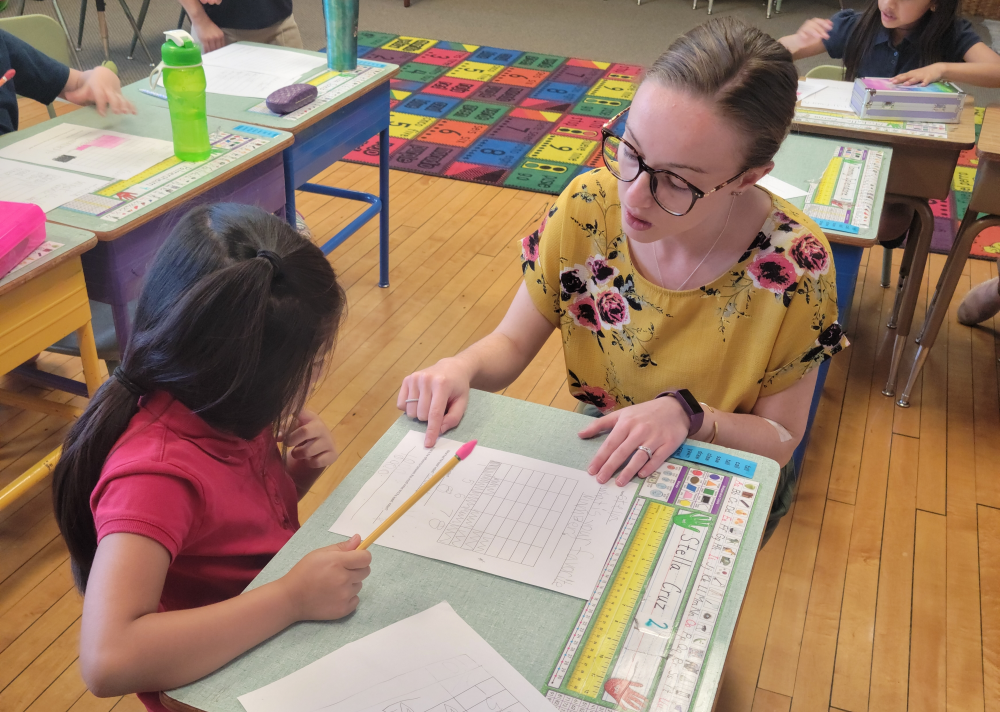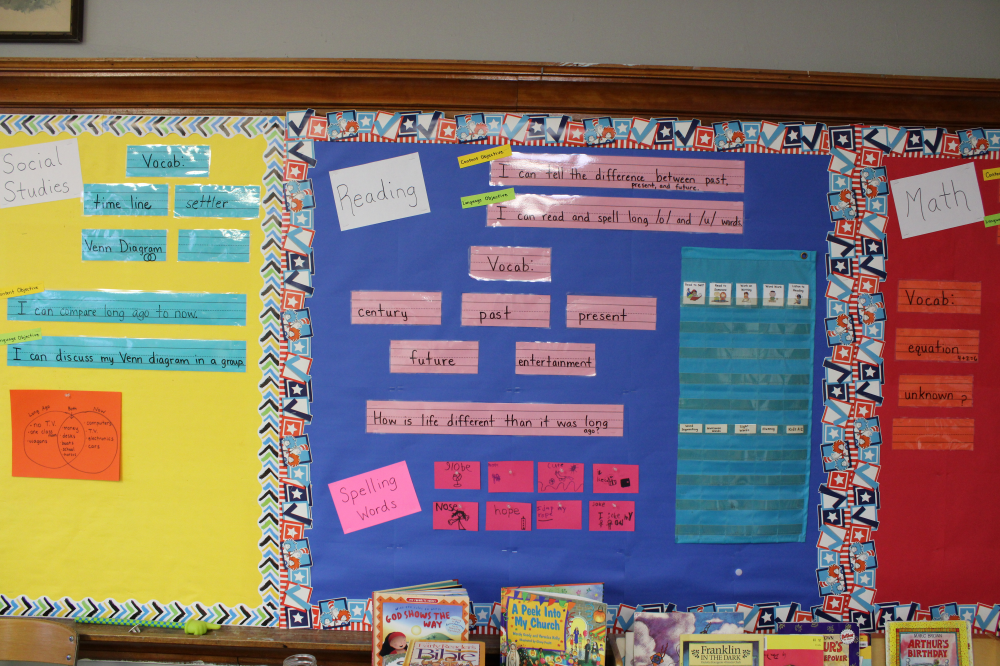Discover the Difference: English as a New Language Program
by Diocese of Des Moines | May 23, 2022

When American Catholic schools were founded over a century ago, the goal was to serve the children of immigrants and marginalized members of society by providing a faith-centered education that respects every student's unique gifts and cultures. The dynamic growth of Catholic schools was directly related to the surge of immigrants in the late 1800s and early 1900s. The same is true today, as much of the recent enrollment growth realized in Catholic schools has been through a growing Latino immigrant population.
"Catholic schools cultivate healthy interaction among the increasingly diverse populations of our society," (USCCB, 2005, p. 4) and remain a viable source of academic excellence and cultural understanding. This commitment to serving growing immigrant communities with compassion and support has contributed to the outstanding educational and social outcomes attained by students of diverse backgrounds who attend Catholic schools. For example, Latino students in Catholic schools tend to outperform their Caucasian counterparts in public schools on national tests and academic benchmarks (Jeynes, 2007). Moreover, Latino students in Catholic schools are more likely to graduate high school and college.
And many of the immigrant students served by Catholic schools are English learners, students who speak a language other than English at home. This group of students is the fastest and largest growing population in U.S. schools, now representing one in four students. St. Patrick Catholic School in Perry, Iowa, has seen this growth in linguistically and culturally diverse students first-hand. This past school year, 43 percent of their student population were English learners.
The school's administrator, Dr. Kandice Patillo, had recently attended the Latino Enrollment Institute (LEI) through the University of Notre Dame. During her studies, she learned of additional opportunities at LEI that could help address the academic, social and linguistic needs of the school's growing Latino population. One of these opportunities was the English as a New Language (ENL) program, which cultivates expertise in classroom teachers to ensure that culturally and linguistically diverse children thrive in Catholic schools.
"I liked the potential that the English as a New Language program could offer our classroom teachers," recalled Patillo. "With this program, our teachers could truly serve the English learners more fully."
Upon returning from her studies at Notre Dame, Patillo had just the right teacher in mind to attend the ENL program -- First grade teacher, Amy Smith. Smith, a fourth-year teacher at St. Patrick, earned her bachelor's degree in Early Childhood Education with a Special Education Endorsement from Indiana University. Patillo recommended Smith for the ENL program because of her passion for Catholic education coupled with the value she places on students' backgrounds, interests, and familial values.
"Amy continually works to meet the needs of her students and this program would provide her with even more tools to do this effectively," said Patillo. "She [Smith] was already an exceptional teacher and a leader in our building. Her participation in this program was a natural fit for her skill set and her desire to share her knowledge with her colleagues."
"I was hesitant to attend the ENL program for years," recalled Smith. "Kandice [Patillo] gently reminded me of the amazing opportunity ENL offered each year, and I finally took the leap. It's been the best decision I've made as an educator."
Smith credits her ability to be a more culturally responsive teacher to her classes at Notre Dame. "I've learned how to intentionally plan for the language my students will encounter in each subject. I've also learned how to bring my student's cultures into my classroom through home visits, interest inventories, and simple conversations with the students," she said.
Her English learner students now experience a classroom where the academic lessons reflect their cultures, which helps students feel welcome and engaged in their studies. This matters because highly engaged students demonstrate improved academic achievement, increased satisfaction, better social skills, and resiliency to persist through academic struggles (Finley, 2015).
Through her experience with the ENL program, Smith is more intentional with planning her lessons. She integrates experiential activities that help students practice the language in each subject. Together as a class, they read, write, listen, and speak daily in multiple ways. Smith also altered her classroom bulletin board to include each subject, complete with the content objective for the day, the language objective, important vocabulary words, and examples of student work. Students reference these boards often throughout the day to help them engage with the lesson and see what they will learn that day.
planning her lessons. She integrates experiential activities that help students practice the language in each subject. Together as a class, they read, write, listen, and speak daily in multiple ways. Smith also altered her classroom bulletin board to include each subject, complete with the content objective for the day, the language objective, important vocabulary words, and examples of student work. Students reference these boards often throughout the day to help them engage with the lesson and see what they will learn that day.
"As teachers, it is our job to amplify our scaffolding in a lesson to ensure that the material is comprehensible and accessible to all students. Our English learner students especially need language amplified in the classroom to help them become successful speakers and learners," said Smith. "Notre Dame shifted my thinking to view these students as emergent bilinguals. Instead of having a deficit mindset and seeing what these kids are lacking, we look at each student's strengths and recognize that the goal of their education is to help them become bilingual students. It's truly their superpower!"
As Smith prepares for the next school year, she will continue her education on implementing a Sheltered Instruction Observation Protocol (SIOP) Model in the classroom. SIOP is a research-based instructional model that addresses the academic needs of English learners. This model will empower Smith to design interactive, language-rich lessons through multiple domains helping her better reach and teach all her English learner students.
"We are really starting to see our students learning English as their second language and reaching proficiency through the extra support our school can offer through the ENL program," shared Patillo. "I am excited to see our English Learner supports expand in the next school year."
Located in Perry, Iowa, St. Patrick Catholic School offers an academically rigorous, faith-based education for students in prekindergarten through eighth grade. Fully accredited in Iowa, our school challenges students to aim higher academically, spiritually, and personally through faith-centered learning and a rigorous academic program aligned with state and diocesan standards. As a result of this commitment to academic excellence, our students consistently perform in the top ten percent of students on Iowa Assessments. To learn more, visit www.stpatricks-perry-ia.org.
The Diocese of Des Moines Catholic Schools includes 16 schools in 23 counties in central and southwest Iowa. Catholic schools in the Des Moines Diocese build Christ-centered, collaborative, inclusive partnerships with parents, students, and parishes to provide students with innovative academic excellence and inspirational faith formation. To learn more about Catholic schools in the Diocese of Des Moines, visit www.dmdiocese.org/catholic-schools or email ExpectMore@dmdiocese.org.
Sources:
Finley, T. (2015). Engage Kids With 7 Times the Effect. Retrieved May 16, 2022 from https://www.edutopia.org/blog/engage-with-7x-the-effect-todd-finley.
Hunt, T. C. (2000). The History of Catholic Schools in the United States: An Overview. New York: Falmer.
Jeynes, W.H. (2007). Religion, Intact Families, & the Achievement Gap. Interdisciplinary Journal of Research on Religion, 3, 1-24; Marks, H.M., and Lee V.E. (1989). National Assessment of Educational Proficiency in Reading 1985-1986: Catholic and Public Schools Compared. Washington, DC: National Catholic Educational Association.
Kealey, C.M. & Kealey, R.J. (2003). On Their Shoulders: A Short Biographical History of American Catholic Schools. Washington, DC: National Catholic Educational Association.
The University of Notre Dame. Alliance for Catholic Education (ACE) (2022). Expanding Access to Catholic Schools. Retrieved May 16, 2022 from https://ace.nd.edu/expanding-access.
United States Conference of Catholic Bishops, Inc. (USCCB). (2005). Renewing Our Commitment to Catholic Elementary and Secondary Schools in the Third Millennium. Retrieved May 16, 2022 from USCCB.org